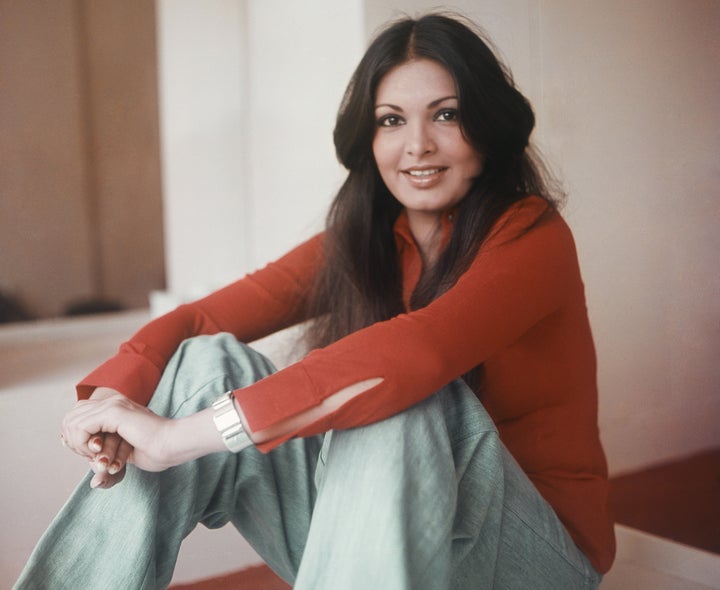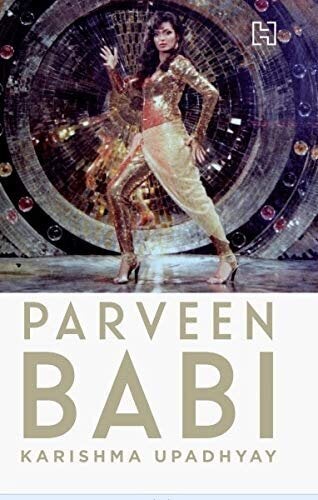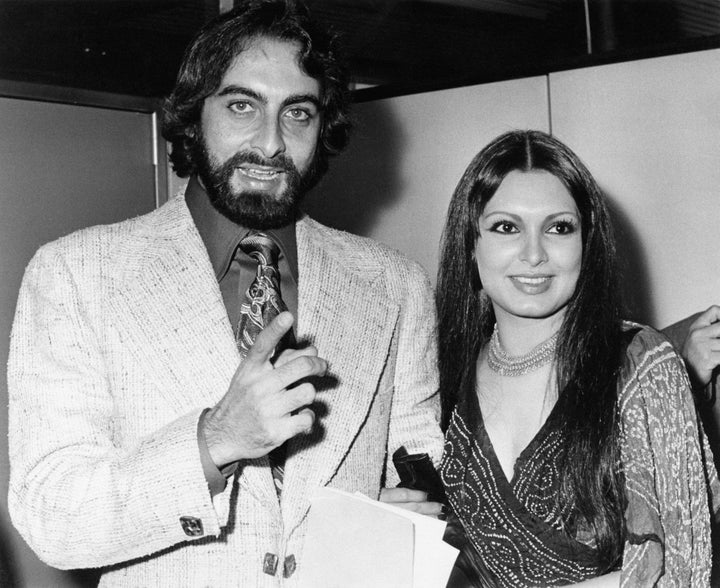
“If you try to stop me, I’ll jump out of the car and strip right here!” the manic woman warned the man accompanying her. Having worked with her long enough as her manager, he knew this wasn’t an empty threat... Although it was close to midnight, there was enough traffic on the flyover to ensure that if she did strip, as she was threatening to, the act would make the headlines. For the actress in question was Parveen Babi and her companion, her trusted manager, Ved Sharma.
These are the sensational opening lines of Parveen Babi: A Life (2020), the latest celebrity biography to hit the market. Journalist Karishma Upadhyay chronicles the life of an actor who was the darling of Hindi film audiences during the 1970s and 1980s but never had her contributions documented in the manner they deserved. This book was a much-needed exercise but unfortunately, it does not live up to its promise of “rescuing Parveen’s legacy from the bondage of myth and gossip.” Instead, it provides credence to rumours and uses conversations with ex-lovers to tell the story of a woman who “refused to acknowledge that the demons in her head were real” and whose “life was like a mirror that had shattered into a million pieces.”
Babi, who died in 2005 at the age of 51, appeared in some of the most iconic movies of her time—Yash Chopra’s Deewaar (1975), Manmohan Desai’s Amar Akbar Anthony (1977), Ramesh Sippy’s Shaan (1980), Manoj Kumar’s Kranti (1981), Tinnu Anand’s Kaalia (1981), Kamal Amrohi’s Razia Sultan (1983)—but Upadhyay frames her narrative primarily through the lens of mental illness. For example, Babi’s “unhealthy possessiveness, acute jealousy and irrational anger” in relation to Protima Bedi, the wife of her ex-lover Kabir Bedi, are interpreted by the author as “a sign of a serious mental health issue.” When this connection is made, it reads like a ‘diagnosis’ that is uncalled for.
In another instance, Rakesh Kumar, who directed Babi in Do Aur Do Paanch (1980), is quoted as saying, “Parveen always seemed like she was on the edge, always tense...And she would be chain-smoking, which was something I didn’t like.” This filmmaker is no psychiatrist but Upadhyay hands him the mic as he pathologises Babi. From Babi’s former college roommates, the author learns that her closet “was a mess of bags, shoes, linen and clothes” and that Babi would “wait until her bucket overflowed” unlike other girls who did their laundry daily. “The rare occasions on which she did get down to sorting out the clutter she had created, her zeal bordered on the obsessive,” writes Upadhyay. This is the reality of many hostel residents; interpreting it as a mental health condition seems far-fetched.
Upadhyay’s approach to chronicling Babi’s eventful life seems to diminish the actor’s professional achievements because her mental health hogs the spotlight in this book. It could prevent readers from seeing her as a person of courage and creativity who reinvented herself every time life dealt her a blow. Upadhyay writes, “However intelligent or insightful one may be, schizophrenia affects the way one thinks, feels and behaves. Fear and delusions can cloud the mind to such an extent that one risks losing all touch with reality. Imagine having a chorus of angry, disembodied voices shouting at you...Parveen was now living this never-ending nightmare.”
The author presents this information without citing any books or articles written by mental health professionals. This absence is shocking because mental health is a serious subject, and should not be written about without adequate research. In an article titled Mental Health in India: Looking Through a Filter of Colonialism and Casteism (2020), therapist-researcher Sadaf Vidha writes, “Our ideas of ‘madness’ and ‘abnormality’ are actually quite Western. Before the advent of colonialism, we did not lock up people who manifested signs like ‘hearing voices’. It was given a more spiritual tone. Secondly, the mind and body were conceptualized as connected.”

In the preface, Upadhyay writes that when she was approached to work on this book, she “knew almost nothing about the glamorous actress” apart from a handful of hit songs featuring her. However, she was intrigued by “the air of mystery” surrounding Babi and “the prospect of digging through hundreds of old magazines, speaking to an entire generation of people in the film industry and tracing sources who would be authentic.” Babi’s secretary Ved Sharma, her designer Xerxes Bhathena and her make-up artist Bharat Godambe, provide a wealth of insider insight. Upadhyay’s other informants from the film industry include Danny Denzongpa, Hema Malini, Sanjay Khan, Zarine Khan, Anju Mahendru, Deepti Naval, Ketan Anand, Saawan Kumar Tak, and Aruna Raje.
“Upadhyay’s approach to chronicling Babi’s eventful life seems to diminish the actor’s professional achievements because her mental health hogs the spotlight in this book”
Writing about an actor who is not present in flesh and blood to answer queries, verify facts and refute accusations is a challenging task for a biographer, especially when the subject’s life was mostly filtered through the lens of allegations and hearsay during her professional peak. To Upadhyay’s credit, she tries to make up for this by using published sources that also include recollections of Babi, such as Protima Bedi’s book Timepass: The Memoirs of Protima Bedi (2000), Mahesh Bhatt’s book U. G. Krishnamurti: A Life (2001), Rachel Dwyer’s book Yash Chopra: Fifty Years in Indian Cinema (2002), Christo Bob’s book Flashback: My Life and Times in Bollywood and Beyond (2011), Ram Kamal Mukherjee’s book Hema Malini: Beyond the Dream Girl, and Sanjay Khan’s book The Best Mistakes of My Life (2018).
Upadhyay has also tried to understand her protagonist’s inner life by referring to the actor’s first-person narrative The Confessions of Parveen Babi (1984), published in the Illustrated Weekly of India. However, the portrait Upadhyay constructs for the reader is marred by her own limited understanding of mental health. For example, she is dismissive of Babi’s fear that her co-actor Amitabh Bachchan wanted to kill her. She writes, “Once the tirade had started, there was no stopping Parveen and everything she said subsequently sounded more ludicrous than ever.” This judgemental tone pushes the readers to disregard any feelings of empathy that might arise when they try to give Babi the patient listening she deserves.
There is no need to confirm or deny Babi’s belief that Bachchan was indeed making plans to harm her. However, Upadhyay does lose out on a crucial opportunity to explore the tensions in the Bachchan-Babi relationship that might have led her protagonist to perceive this threat in the first place. The author seems so eager to locate Babi’s mental distress in her own disposition that she overlooks the role of trauma from Babi’s childhood and adolescent years in shaping her mental health journey in her later life.
In 1969, when Babi was a student at St. Xavier’s College, Ahmedabad, she went through a scarring experience that left a strong impression on her. Upadhyay mentions that it was a time when communal violence had “peak(ed) to barbaric levels, leading to wide-scale massacres, multiple acts of arson and rampant looting.” With over 500 people being killed, and thousands of homes destroyed across the city, educational institutions decided to shut down for a while. Babi stayed indoors along with all the other girls at the hostel.
Concerned about Babi’s safety as a Muslim woman, the warden felt that she would be better off in her local guardian Pankaj Zaveri’s home. Upadhyay writes, “Under cover of darkness, the young girl was, therefore, hidden under a mattress and a massive pile of blankets in the back of a truck and transported to the Zaveris’ home.” Years later, Babi is said to have told her ex-lover filmmaker Mahesh Bhatt, “You don’t know what it is [like] to lie hidden under several blankets, dreading the moment when the furious rioters would pull off the mattresses and rape me.”
“While the trauma experienced by children of Holocaust survivors has been written about extensively, similar research around the Partition is rarely addressed by mainstream clinical psychiatry.”
Upadhyay’s book would have benefited from a more rigorous analysis of the research material at her disposal. Though readers are informed that Babi came from an aristocratic family in Junagadh, a princely state that was caught in a bitter political battle between India and Pakistan in 1947, Upadhyay does not explore what the intergenerational trauma of Partition running within the family would have triggered for Babi during the communal violence in Ahmedabad. Babi’s father used to work for the Nawab of Junagadh. When the Nawab migrated to Karachi, her father lost his land, job and title. The family was in dire straits. Many of her mother’s relatives also went to Pakistan.
Urvashi Butalia’s edited volume Partition: The Long Shadow (2015) includes a chapter titled Bad Times and Sad Moods written by Alok Sarin, Sarah Ghani and Sanjeev Jain. They highlight how Partition “was accompanied by large-scale migrations, violence and the breakdown of established civic life in large parts of the region” but there was hardly any “administrative or medical infrastructure to cope with this unprecedented transmigration, especially since this was attended by horrific acts of violence, looting and sexual assault.” While the trauma experienced by children of Holocaust survivors has been written about extensively, similar research around the Partition is rarely addressed by mainstream clinical psychiatry.
Upadhyay reveals that Babi’s mother had fixed her engagement with a pilot employed with Pakistan International Airlines. They got engaged in Karachi during her winter break from college, and she fell in love with him as they kept in touch. But they never got married as Babi’s mother put an end to their relationship in 1971.
Upadhyay mentions that the strained diplomatic ties between India and Pakistan ahead of the formation of Bangladesh worried Babi’s mother because memories of Partition were still fresh in her mind. Family members believe that “fear of the hostilities between the two countries affecting Parveen’s marriage” made her call off the engagement. Babi got the news via a postcard. When she read it, she felt “like her entire being had died.”
The author adds that, in 2002, Babi filed an affidavit, claiming that she had “highly incriminating documentary evidence against actor Sanjay Dutt for his alleged involvement in the 1993 Mumbai bomb blast cases.” “The affidavit named a host of co-conspirators ― the US, UK, and Indian governments, intelligence agencies like the CBI, the ISI, the CIA and the British secret service, Amitabh Bachchan, Prince Charles and founder of the Shiv Sena, Bal Thackeray ― who were also apparently trying to kill her,” Upadhyay writes. Babi’s testimony was never recorded because she did not show up in court thrice, saying that she might get killed en route. Instead of linking this back to Babi’s long history with communal violence, Upadhyay tells readers that “the media had branded her insane,” and the “beautiful home that she had lovingly designed and maintained was now filthy and in a perpetual state of neglect.”

Upadhyay’s research has brought to light some significant details about Babi’s life, and they can be probed further to understand the socio-political factors involved in mental health. The Power Threat Meaning Framework, published by the British Psychological Society in 2018, shows that reducing a person to their psychiatric diagnosis provides a limited way to comprehend behaviour that is labelled as troubled or troubling. Instead of medicalizing a person’s experience by asking ‘What is wrong with you?’, it offers four alternative questions. These are: 1. ‘What has happened to you?’ 2. ‘How did it affect you?’ 3. ‘What sense did you make of it?’ 4. ‘What did you have to do to survive?’
Unfortunately, Upadhyay’s book does not reflect this sensitivity. She presents Babi as a person who was “a social chameleon” leading a life that was “an encyclopaedia of excesses.” The actor is described as obsessed with getting attention from her lovers, and responsible for her own downfall. This seems like an entirely uncharitable approach to revisit the memory of one of India’s most iconic performers, who strove to make a mark in a misogynistic workplace on her own strength. Upadhyay speaks of Babi’s rivalries with Zeenat Aman, Mallika Sarabhai and Protima Bedi but does not draw parallels with other actors who have been stigmatized for mental illness.
A person’s mental health is affected by the institutions they are part of but Upadhyay does not hold the film industry accountable for what happened to Babi. She exaggerates the hardships faced by film directors when Babi could not turn up for work due to her mental state. The professionalism displayed by Babi in other contexts—punctuality on sets, rehearsing dialogues well in advance to prevent retakes, addressing spot boys and technicians by their names, promptly returning signing amounts when she could not do a film—are underplayed. Focusing on these could have created an entirely different picture for readers.
Upadhyay writes, “Even as she was plagued by hallucinations and delusions, there was no denying that Parveen was still highly functional.” These health conditions are named without definitions or explanations. That can be dangerous because the book is for a general audience which is likely to be unfamiliar with the meanings of these words. Towards the end of the book, her friend and spiritual guru U.G. Krishnamurti is quoted as saying in 1984 that Babi’s case was “one of misdiagnosis.” Readers are left with the information that “it is difficult to distinguish between schizo[phrenia] and manic depression,” which will certainly provide fodder for speculation.
Upadhyay is not the first biographer to fetishize her protagonist’s suffering. Her book is reminiscent of journalist Vinod Mehta’s book Meena Kumari: The Classic Biography, first published in 1972 and re-issued in 2013. Mehta writes, “One of the paradoxes of death is that it demands explanations—and a mixed bag was offered...she was unhappy; she was friendless; she was drinking too much; she was unable to find true love; she was betrayed. And inevitably the final and subsequently the most accepted conclusion: possibly she was better off dead than alive.”
“It would be a travesty to reduce her rich inner world by seeing it only through the limiting lens of sanity, normalcy and madness.”
We know from Upadhyay’s book that Babi had an abiding interest in literature and philosophy. She read writers such as Jean-Paul Sartre and Richard Bach, and was a frequent visitor to bookstores. She acted in plays based on scripts by writers Ayn Rand and Badal Sircar. She attended lectures by J. Krishnamurti and U.G. Krishnamurti. She was exposed to Buddhism, and converted from Islam to Christianity towards the end of her life. She painted, wrote short stories, and maintained journals. It would be a travesty to reduce her rich inner world by seeing it only through the limiting lens of sanity, normalcy and madness.
Future biographers of Babi would be able to give a more nuanced account of her life by studying how it was shaped by the loss of her father when she was only six years old, and the fact that she and her mother did not share any emotional intimacy throughout their life. Her lifelong search for an “attachment figure”—a psychological term for a person who could have her back—should not be read as desperate or abnormal. Isn’t the need for care, protection, love and safety felt by all human beings, regardless of whether they belong to showbiz or not?